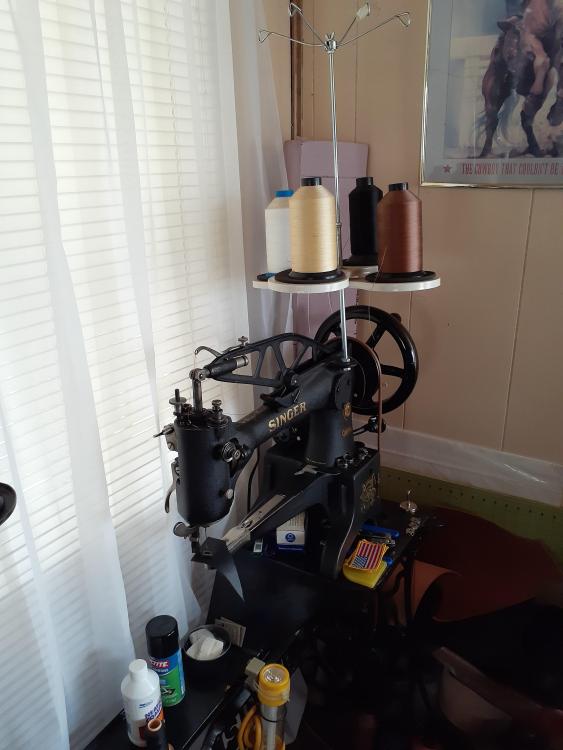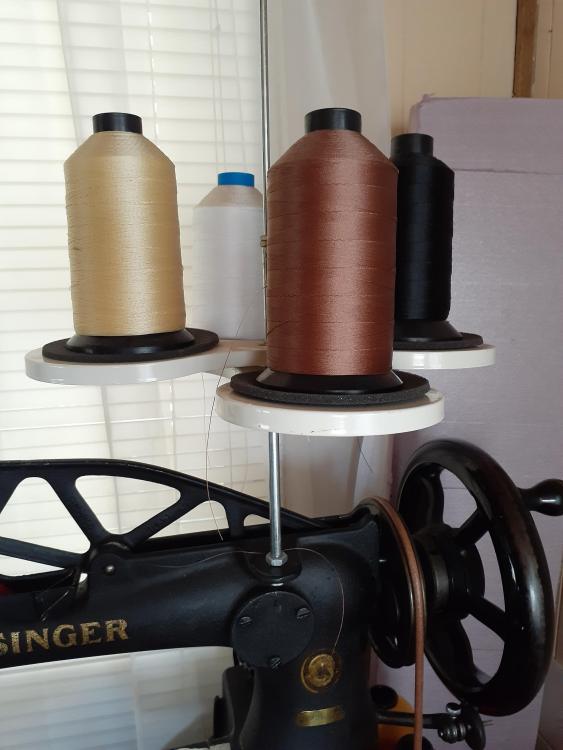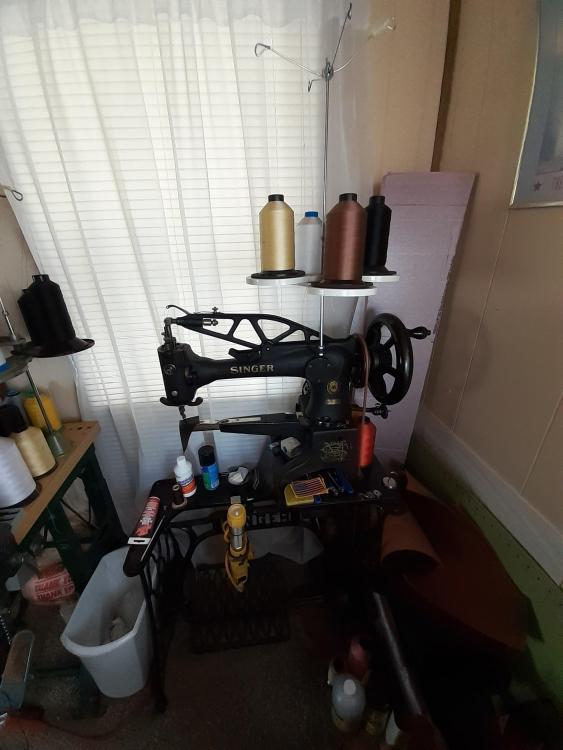-
Posts
7,778 -
Joined
-
Last visited
Content Type
Profiles
Forums
Events
Blogs
Gallery
Everything posted by Wizcrafts
-
Here you go: https://d28lcup14p4e72.cloudfront.net/197085/3767937/SingerModel29UFAManual.pdf
-
I would advise you to join the forum (it's free), then post this ad in our Marketplace sub-forum, under the sewing equipment > Used section. You will get more replies and they won't need to be approved before being unhidden. PS: Either way, please include your location! We have an international user base.
-
You have a photo of the back side. You'll get better responses from a frontal view of the head, preferably a close up of the head portion.
-
Twenty ounces of Herman Oak carved, dyed and finished is probably on the hard density end, just not the hardest. What I consider medium density would be apron suede, or biker's chap sides, or perhaps saddlebag leather. I have had some bridle leather that was very easy to sew, while other cuts were tougher. Sometimes there are remnants of rawhide along the backbones on sides and double bends. Rawhide itself has a hard density. Garment leather has a soft density. The real test of density has to be determined by testing a sewing machine with the largest size thread and needle combination it can handle. If the foot pressure spring can't hold down the leather as the needle and thread come up out of the top side, or if the knots can't be pulled inside the layers and completely hidden on both sides, it is insufficient for that kind of sewing and the density of the leather. I hope this explanation helps a little. Important facts: There is a HUGE difference in the foot pressure to hold down between 5/16 and 3/8 inches of veg-tan leather versus 8 to 10 ounces of the same type of leather. There is a big difference in the amount of top tensioner spring tension needed to pull knots up inside 24 ounces vs 10 ounces with thread sizes 138 and up. For a given machine to happily sew 20+ ounces of veg-tan with #207, or #277 bonded thread, it must have really strong springs and very beefy crank shafts, take-up lever and bearings on load bearing parts. In order to penetrate 20+ ounces of veg-tan leather will also require a very high motor to machine pulley ratio, possibly involving a speed reducer between the motor and balance wheel. The feeling I get from your inquiry is that you intend to sew finished, medium hard to hard density leather stacks easily reaching and probably exceeding 20 ounces. This is the high end of the typical sewing capacity of upholstery grade machines. They are not built with such usage in mind. Upholstery leather is relatively soft at the thicknesses usually encountered in making seat and sofa covers, or carrying bags. I therefore recommend that you take a serious look at the Cowboy CB3200, as it won't be over-stressed sewing 24 ounces of veg-tan with #277 thread, using a #25 leather point needle. This thread is a good match for 3/8 inch of leather, having 44 pounds of breaking strength per locked stitch. If you end up having to sew jobs under about 6 - 8 ounces, search for a used upholstery grade walking foot machine. Upholstery shops often sell off old walking foot machines when the buy new ones, or downsize. These machines can sew from a few ounces to almost 3/8 of an inch, but only with up to #138 bonded thread, which only has 22 pounds test. I wrote an extensive article, pinned near the top of this forum, describing the type of sewing machine you need to sew leather. It makes a good read and may help you choose a most suitable machine. Note, we have a section here called the Marketplace, which has a section where people can sell their used, or rebuilt sewing machines to other members. You should peruse that section to see if anybody in your area of the World might have a suitable machine for sale at a price you can afford.
-

Which (used) machine for an Aussie noob?
Wizcrafts replied to Fognozzle's topic in Leather Sewing Machines
I have a Singer 42-5 in my (now closed) leather shop. I use it to sew chaps and heavy upholstery, like motorcycle seats. I actually bought a handful of bobbins from somebody in Australia. I forget who. I am able to fit exactly 5/16 inch under the feet. Not one iota more. It feeds very reliably and has sharp teeth on the feed dog. I also got a good supply of authentic Singer leather point needles for and with the machine (System 88?). Those needles are now irreplaceable. Anybody with a 42-5 who doesn't have the proper needles may have to lower the needle bar to use System 135x16, which will reduce the maximum sewing thickness to 1/4 inch. -

Which (used) machine for an Aussie noob?
Wizcrafts replied to Fognozzle's topic in Leather Sewing Machines
You may be right. It's been a year since I changed pulleys on a mounted motor. Let's just say "a new v-belt to mach the different pulley." -

Which (used) machine for an Aussie noob?
Wizcrafts replied to Fognozzle's topic in Leather Sewing Machines
Clutch motors are easy to tweak via a bolt on the front left, in front ot eh output axle. Backing it out gives more slack before she engages. Then you can adjust the spring on the right end of the control lever to push it up more or less. Of course, the position of the foot pedal can be adjusted to suit your foot or shoe profile. Finally, a very small motor pulley will slow it way down. I recommend a 50mm or smaller machine pulley and a longer type 3L belt to match. -
I'd say it is very similar to a Consew 206RB-5. The bobbin is on the left end, accessed by sliding the bobbin access cover plate to the left. It uses M style bobbins like the 206 and has the same needles and presser feet. One difference is that the Fabricator is optimized for sewing canvas, vinyl and Sunbrella, not leather. The maximum thickness is about 1/8 inch less than the Consew 206.
-
Pay no attention to the man behind the curtain... The motor has been there for about 10 years. The guy I bought it from attached the motor 5 years before I bought it. I can tell you that the motor is a 1.5 amp model and it won't start the machine by itself unless the hand wheel is disengaged by the bobbin winder friction disk. I stopped trying to use it a few years ago but left in attached for shits and giggles. Now, I either hand wheel or treadle it. You should see the motor on my Adler 30-7 patcher! 1/2 horsepower clutch motor running through a speed reducer. I love to hear machines going ta-pocketa-pocketa
-

insole stitcher needle size 45x230 = which thread?
Wizcrafts replied to Con's topic in Leather Sewing Machines
Oy Vey! That's one hell of a non answer. See if there are any social media user groups for Robin Industry. Maybe somebody somewhere owns these machines and can actually give accurate information. -

Which (used) machine for an Aussie noob?
Wizcrafts replied to Fognozzle's topic in Leather Sewing Machines
I don't mean to discourage potential buyers of spring foot machines, but I used to own a Singer 132k6 and currently have a 42-5. They work great is the top grain isn't slick. The top foot needs to dig into the top and follow it back with the bottom feed dog. When the dog reaches the back of its travel and drops down, the spring foot springs forward, just like Daylight Saving Time! BUT; there's always a but... I learned that if the material is slick on top, the spring foot just slides uselessly on the top and fights the feed dog's action. The 132k6 turned out to be a huge disappointment to me for sewing polished surfaces, like stamped and polished belts and holsters. The stitch length varied wildly as the foot slipped over the top. TBT, the Singer 132k6 was marketed as a buffing wheel sewing machine and there was an attachment that moved stacks of round cloth in a circle and away from the needle as it sewed arcs. That's why they have a long 1/2 inch maximum stitch length and 1/2 inch clearance under the feet. -
A close-up look at the head shows that it uses standard Singer 111 compound feed walking foot machine feet. They are sold everywhere industrial sewing machines are sold. The same feet are used on Consew, Juki and dozens of other brands that are based on the Singer 111w155. Note: This machine doesn't use the feet from the smaller portable Sailrite machines. Those are only dual, top/bottom feed machines that have specialized feet with teeth on the bottom.
-
If you are asking if this machine can use external spools for the bottom thread, the answer is NO.
-

insole stitcher needle size 45x230 = which thread?
Wizcrafts replied to Con's topic in Leather Sewing Machines
Not only have they not answered you; they haven't answered my email or Facebook Messenger questions either. Methinks they may be (temporarily?) closed for business. -
I removed the spool pin on the upper right and drilled it out to fit the bottom of an industrial thread stand. There is a nut and lock-washer on the bottom of the bracket holding everything in place. This works like a charm and gives me 4 spools to choose from. As I change colors of top thread I simply cut the old thread about halfway down from the thread guide above and tie in the new color. Then I lift the presser foot to release the tension disks, un-thread the needle and.pull the old and new thread all the way through the mechanism. I only need my threading rod when I accidentally pull the old thread too far up the snout. This patcher is always loaded with #69 bonded thread, on top and in the bobbins, with a #18 titanium needle. It can accept #92 thread if needed, which calls for a #19 or #20 needle.
-
As they are occasionally in the US market. However, all of those modern system 29 needles I have bought are merely repackaged System 135x16. The reason I say this is because they all have a cutout scarf above the eye and are almost the exact same length as walking foot needles, whereas the original 29x3/4 didn't have a scarf. I have a few of these original no-scarf needles left from a previous purchase and they definitely perform differently than walking foot needles. You can set these needles so close to the hook that it actually makes slight contact above the eye. If any of you know where I can buy some actual System 29x4 without a scarf, please let me know.
-

insole stitcher needle size 45x230 = which thread?
Wizcrafts replied to Con's topic in Leather Sewing Machines
I just sent a message to Robin on Facebook, asking about the thread and needle handling maximums (and max stitch length) and if they supply needles. I will post their reply after I get it. -

insole stitcher needle size 45x230 = which thread?
Wizcrafts replied to Con's topic in Leather Sewing Machines
As a follow-up, I recommend contacting Robin about where they get their needles and if they can supply them to you in various "sizes." FYI: There is no needle size commonly available that can easily pass 1mm waxed thread in a closed eye lockstitch machine currently in production. The largest needle listed in this chart is a #30 (Metric 330). Even that huge needle isn't large enough to clear 1mm diameter thread, especially if it is waxed. What machine do you need to sew with 1mm waxed linen thread? You need a shoe sole stitcher like a Landis 12 series curved needle and awl lockstitch machine. There might possibly be some huge needles and awls available for a McKay insole chainstitch machine, which is really what you'll want for midsoles. Here is a YouTube video about the McKay stitcher's threading and usage. Campbell-Randall Lockstitch, Union Lockstitch and Landis 3 are needle and awl machines then can take huge needles and awls, IF there are any still available. I used to own a Union Lockstitch machine and had acquired a huge assortment of needles, some of which could handle 10 cord linen thread! They closely resembled roofing nails! My personal guess is that the Robin machine in question may be limited to about 1/2 mm thread. The needle size required for that diameter is #23 (metric #160) -

insole stitcher needle size 45x230 = which thread?
Wizcrafts replied to Con's topic in Leather Sewing Machines
This is a needle "System," not a size. The system seems to be rare. I have only found these needles for sale in Germany (online stores) and then only in "size" 26. This is a very big needle that can sew with up to #346 bonded nylon thread. -
I just keep a small precision screwdriver on the end of the table and use it to pry the bobbin out on one side.
-
You can buy an anti-backlash spring and drop it into the bobbin basket. It raises the bobbins and prevents bobbin rotation run-on after sewing at high speed and stopping quickly.
-
First, make sure the machine is threaded correctly and that the needle is aligned correctly! The rib should be on the left and scarf on the right when you are in front of the arm. Also, make sure you are using the correct needle system! The original was System 29x3 and 29x4, which are obsolete. The modern equivalent is System 135x16 and 135x17 (common walking foot needles). If this is already set, then the timing of the hook is probably out and needs to be readjusted. Open the throat cover plate to expose the hook so you can see which way it needs to move to intersect the needle at the right moment. When timed correctly, the hook intersects the needle above the eye, inside the scarf area, after the needle has reached bottom dead center, then moved up slightly, then halted, or just starts to move down again. If the hook passes the needle before or after these events it skips stitches. There is a hole in the lower base, on the right side. This is a screwdriver hole. Inside there is a crank shaft coming down that meets one going through the arm, which drives the shuttle. There is an eccentric screw holding the shafts together and there is a locking nut on the back of them. It is tricky to get a box end wrench under the arm and into the lower section, but it is doable. Loosen the locknut slightly, then stick a flat blade screwdriver through the access hole. Rotate the hand wheel to bring the eccentric screw into alignment with the hole and turn it one way or the other about 1/2 turn, then check how close the hook tip comes to the needle when the needle has moved down, then up and halted. It is at this point that the hook should be approaching the center of the needle, just about the eye, in the cutout scarf. If you are using the correct needle system, aligned properly and it is set to be close to the hook, but the hook can't be adjusted to intersect it after it makes the aforementioned jog, the shuttle driving gears may have slipped out of time. That is a big deal and I won't dive into it here. If you are not skilled with repairing industrial sewing machines, contact a dealer who can repair it for you.
-

New machine selection.... Durkopp Adler - Juki 441 clone
Wizcrafts replied to anvilring's topic in Leather Sewing Machines
You can call Bob Kovar, owner of Toledo Industrial Sewing Machines, at 866-362-7397. He is the primary dealer for Cowboy machines in the US and Canada. He will know if there are single toe presser feet for their Adler 205 clone. Or, he can grind off the right toe on a standard presser foot. -

New machine selection.... Durkopp Adler - Juki 441 clone
Wizcrafts replied to anvilring's topic in Leather Sewing Machines
I may be wrong, it has been a long time since I sat down at a 205, but I don't think that the presser feet for a 441 will fit on the Adler presser bar. I think the Adler presser feet have a totally round mount. Parts, like spacers and other presser feet are likely still be available from or through Weaver Leather, as they are a recognized sales partner of Durkopp Adler and Pfaff. Other industrial sewing machine dealers can probably order parts for you. If you have a heart or blood pressure problem you should probably take your meds before looking at the prices at Weaver. You have a genuine Adler 205, not a clone and not a 441 machine. -
You should start a new topic to discuss electronic positioning vs. a plain servo motor. This topic was last updated in 2015.





